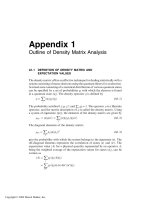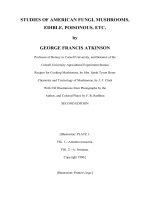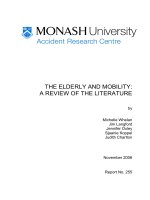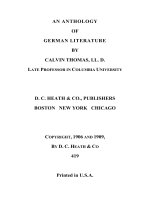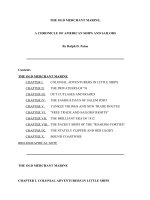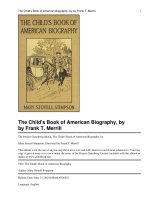Outline of american literature
Bạn đang xem bản rút gọn của tài liệu. Xem và tải ngay bản đầy đủ của tài liệu tại đây (1.96 MB, 318 trang )
By Kathryn VanSpanckeren
Published by the United States Information Agency
Early American and Colonial Period to 1776
American literature begins with the orally
transmitted myths, legends, tales, and lyrics (always
songs) of Indian cultures. There was no written
literature among the more than 500 different Indian
languages and tribal cultures that existed in North
America before the first Europeans arrived. As a
result, Native American oral literature is quite
diverse. Narratives from quasi-nomadic hunting
cultures like the Navajo are different from stories of
settled agricultural tribes such as the pueblo-dwelling
Acoma; the stories of northern lakeside dwellers such
as the Ojibwa often differ radically from stories of
desert tribes like the Hopi.
Tribes maintained their own religions --
worshipping gods, animals, plants, or sacred
persons. Systems of government ranged from
democracies to councils of elders to theocracies.
These tribal variations enter into the oral literature as
well.
Still, it is possible to make a few generalizations.
Indian stories, for example, glow with reverence for
nature as a spiritual as well as physical mother.
Nature is alive and endowed with spiritual forces;
main characters may be animals or plants, often
totems associated with a tribe, group, or individual.
The closest to the Indian sense of holiness in later
American literature is Ralph Waldo Emerson's
transcendental "Over-Soul," which pervades all of
There are no long, standardized religious cycles about
one supreme divinity. The closest equivalents to Old
World spiritual narratives are often accounts of
shamans initiations and voyages. Apart from these,
there are stories about culture heroes such as the
Ojibwa tribe's Manabozho or the Navajo tribe's
Coyote. These tricksters are treated with varying
degrees of respect. In one tale they may act like
heroes, while in another they may seem selfish or
foolish. Although past authorities, such as the Swiss
psychologist Carl Jung, have deprecated trickster tales
as expressing the inferior, amoral side of the psyche,
contemporary scholars -- some of them Native
Americans -- point out that Odysseus and
Prometheus, the revered Greek heroes, are
essentially tricksters as well.
Examples of almost every oral genre can be found in
American Indian literature: lyrics, chants, myths, fairy
tales, humorous anecdotes, incantations, riddles,
proverbs, epics, and legendary histories. Accounts of
migrations and ancestors abound, as do vision or
healing songs and tricksters' tales. Certain creation
stories are particularly popular. In one well-known
creation story, told with variations among many
tribes, a turtle holds up the world. Hence the Indian
name for America, "Turtle Island."
The songs or poetry, like the narratives, range from
the sacred to the light and humorous: There are
lullabies, war chants, love songs, and special songs for
children's games, gambling, various chores, magic, or
dance ceremonials. Generally the songs are repetitive.
Vision songs, often very short, are another
distinctive form. Appearing in dreams or visions,
sometimes with no warning, they may be healing,
hunting, or love songs. Often they are personal, as in
this Modoc song:
I
the song
I walk here. .
Indian oral tradition and its relation to American
literature as a whole is one of the richest and least
explored topics in American studies. The Indian
contribution to America is greater than is often
believed. The hundreds of Indian words in everyday
American English include "canoe," "tobacco,"
"potato," "moccasin," "moose," "persimmon,"
"raccoon," "tomahawk," and "totem.”
Chapter I: Early American and
o 1776
Colonial Period t
The Literature of Exploration
The Colonial Period in new England
Literature in the Southern and Middle
Colonies
Authors
THE LITERATURE OF EXPLORATION
The first known and sustained contact between the
Americas and the rest of the world, began with the
famous voyage of an Italian explorer, Christopher
Columbus, funded by the Spanish rulers Ferdinand
and Isabella. Columbus's journal in his "Epistola,"
printed in 1493, recounts the trip's drama -- the terror
of the men, who feared monsters and thought they
might fall off the edge of the world; the near-mutiny;
how Columbus faked the ships' logs so the men would
not know how much farther they had travelled than
anyone had gone before; and the first sighting of land
as they neared America.
Initial English attempts at colonization were
disasters. The first colony was set up in 1585 at
Roanoke, off the coast of North Carolina; all its
colonists disappeared, and to this day legends are
told about blue-eyed Croatan Indians of the area.
The second colony was more permanent:
Jamestown, established in 1607. It endured
starvation, brutality, and misrule. However, the
literature of the period paints America in glowing
colors as the land of riches and opportunity.
Accounts of the colonizations became worldrenowned. The exploration of Roanoke was carefully
recorded by Thomas Hariot in A Briefe and True
Report of the New-Found Land of Virginia (1588).
The Jamestown colony's main record, the writings of
Captain John Smith, one of its leaders, is the exact
opposite of Hariot's accurate, scientific account.
Smith was an incurable romantic, and he seems to
have embroidered his adventures. To him we owe
the famous story of the Indian maiden, Pocahontas.
Whether fact or fiction, the tale is ingrained in the
American historical imagination. The story recounts
how Pocahontas, favorite daughter of Chief
Powhatan, saved Captain Smith's life when he was a
prisoner of the chief. Later, when the English
persuaded Powhatan to give Pocahontas to them as a
hostage, her gentleness, intelligence, and beauty
impressed the English, and, in 1614, she married John
Rolfe, an English gentleman. The marriage initiated
an eight-year peace between the colonists and the
Indians, ensuring the survival of the struggling new
colony.
In the 17th century, pirates, adventurers, and explorers
opened the way to a second wave of permanent colonists,
bringing their wives, children, farm implements, and
craftsmen's tools. The early literature of exploration,
made up of diaries, letters, travel journals, ships'
logs, and reports to the explorers' financial backers
-- European rulers or, in mercantile England and
Holland, joint stock companies -- gradually was
supplanted by records of the settled colonies. Because
England eventually took possession of the North
American colonies, the best-known and mostanthologized colonial literature is English. As American
minority literature continues to flower in the 20th
century and American life becomes increasingly
multicultural, scholars are rediscovering the importance
of the continent's mixed ethnic heritage. Although the
story of literature now turns to the English accounts, it is
important to recognize its richly cosmopolitan
beginnings.
THE COLONIAL PERIOD IN NEW ENGLAND
It is likely that no other colonists in the history of the
world were as intellectual as the Puritans. Between
1630 and 1690, there were as many university
graduates in the northeastern section of the United
States, known as New England, as in the mother
country -- an astounding fact when one considers that
most educated people of the time were aristocrats
who were unwilling to risk their lives in wilderness
conditions. The self-made and often self-educated
Puritans were notable exceptions. They wanted
education to understand and execute God's will as
they established their colonies throughout New
England.
The Puritan definition of good writing was that
which brought home a full awareness of the
importance of worshipping God and of the spiritual
dangers that the soul faced on Earth. Puritan style
varied enormously -- from complex metaphysical
poetry to homely journals and crushingly pedantic
religious history. Whatever the style or genre,
certain themes remained constant. Life was seen as a
test; failure led to eternal damnation and hellfire,
and success to heavenly bliss. This world was an
arena of constant battle between the forces of God
and the forces of Satan, a formidable enemy with
many disguises. Many Puritans excitedly awaited the
"millennium," when Jesus would return to Earth,
end human misery, and inaugurate 1,000 years of
peace and prosperity.
Scholars have long pointed out the link between
Puritanism and capitalism: Both rest on ambition,
hard work, and an intense striving for success.
Although individual Puritans could not know, in
strict theological terms, whether they were "saved"
and among the elect who would go to heaven,
Puritans tended to feel that earthly success was a
sign of election. Wealth and status were sought not
only for themselves, but as welcome reassurances of
spiritual health and promises of eternal life.
Moreover, the concept of stewardship encouraged
success. The Puritans interpreted all things and
events as symbols with deeper spiritual meanings,
and felt that in advancing their own profit and their
community's well-being, they were also furthering
God's plans. They did not draw lines of distinction
between the secular and religious spheres: All of life
was an expression of the divine will -- a belief that
later resurfaces in Transcendentalism.
In recording ordinary events to reveal their spiritual
meaning, Puritan authors commonly cited the Bible,
chapter and verse. History was a symbolic religious
panorama leading to the Puritan triumph over the
New World and to God's kingdom on Earth.
The first Puritan colonists who settled New England
exemplified the seriousness of Reformation
Christianity. Known as the "Pilgrims," they were a
small group of believers who had migrated from
England to Holland -- even then known for its
religious tolerance -- in 1608, during a time of
persecutions.
Like most Puritans, they interpreted the Bible
literally. They read and acted on the text of the
Second Book of Corinthians -- "Come out from
among them and be ye separate, saith the Lord."
Despairing of purifying the Church of England from
within, "Separatists" formed underground
"covenanted" churches that swore loyalty to the
group instead of the king. Seen as traitors to the king
as well as heretics damned to hell, they were often
persecuted. Their separation took them ultimately to
the New World.
William Bradford
Anne Bradstreet
William Byrd
Jonathan Edwards
Olaudah Equiano (Gustavus Vassa)
Cotton Mather
Mary Rowlandson
Samuel Sewall
Edward Taylor
Michael Wigglesworth
Roger Williams
John Woolman
William Bradford (1590-1657)
William Bradford was elected governor of Plymouth
in the Massachusetts Bay Colony shortly after the
Separatists landed. He was a deeply pious, selfeducated man who had learned several languages,
including Hebrew, in order to "see with his own eyes
the ancient oracles of God in their native beauty." His
participation in the migration to Holland and the
Mayflower voyage to Plymouth, and his duties as
governor, made him ideally suited to be the first
historian of his colony. His history, Of Plymouth
Plantation (1651), is a clear and compelling account of
the colony's beginning.
Bradford also recorded the first document of colonial
self-governance in the English New World, the
"Mayflower Compact," drawn up while the Pilgrims
were still on board ship. The compact was a harbinger
of the Declaration of Independence to come a century
and a half later.
Puritans disapproved of such secular amusements as
dancing and card-playing, which were associated with
ungodly aristocrats and immoral living. Reading or
writing "light" books also fell into this category.
Puritan minds poured their tremendous energies into
nonfiction and pious genres: poetry, sermons,
theological tracts, and histories. Their intimate diaries
and meditations record the rich inner lives of this
introspective and intense people.
Anne Bradstreet (c. 1612-1672)
The first published book of poems by an American
was also the first American book to be published by a
woman -- Anne Bradstreet. It is not surprising that
the book was published in England, given the lack of
printing presses in the early years of the first
American colonies. Born and educated in England,
Anne Bradstreet was the daughter of an earl's estate
manager. She emigrated with her family when she
was 18. Her husband eventually became governor of
the Massachusetts Bay Colony, which later grew into
the great city of Boston. She preferred her long,
religious poems on conventional subjects such as the
seasons, but contemporary readers most enjoy the
witty poems on subjects from daily life and her warm
and loving poems to her husband and children.
She was inspired by English metaphysical poetry, and her
book The Tenth Muse Lately Sprung Up in America (1650)
shows the influence of Edmund Spenser, Philip Sidney,
and other English poets as well. She often uses elaborate
conceits or extended metaphors. “To My Dear and Loving
Husband” (1678) uses the oriental imagery, love theme,
and idea of comparison popular in Europe at the time, but
gives these a pious meaning at the poem‘s conclusion:
If ever two were one, then surely we.
If ever man were loved by wife, then thee;
If ever wife was happy in a man,
Compare with me, ye women, if you can.
I prize thy love more than whole mines of gold
Or all the riches that the East doth hold.
My love is such that rivers cannot quench,
Nor ought but love from thee, give recompense.
Thy love is such I can no way repay,
The heavens reward thee manifold, I pray.
Then while we live, in love let s so persevere
That when we live no more, we may live ever.
Edward Taylor (c. 1644-1729)
Like Anne Bradstreet, and, in fact, all of New
England's first writers, the intense, brilliant poet and
minister Edward Taylor was born in England. The son
of a yeoman farmer -- an independent farmer who
owned his own land -- Taylor was a teacher who
sailed to New England in 1668 rather than take an
oath of loyalty to the Church of England. He studied
at Harvard College, and, like most Harvard-trained
ministers, he knew Greek, Latin, and Hebrew. A
selfless and pious man, Taylor acted as a missionary
to the settlers when he accepted his lifelong job as a
minister in the frontier town of Westfield,
Massachusetts, 160 kilometers into the thickly
forested, wild interior.
Taylor was the best-educated man in the area, and he
put his knowledge to use, working as the town
minister, doctor, and civic leader.
Modest, pious, and hard-working, Taylor never
published his poetry, which was discovered only in
the 1930s. He would, no doubt, have seen his work's
discovery as divine providence; today's readers should
be grateful to have his poems -- the finest examples of
17th-century poetry in North America.
Taylor wrote a variety of verse: funeral elegies, lyrics,
a medieval "debate," and a 500-page Metrical History
of Christianity (mainly a history of martyrs). His best
works, according to modern critics, are the series of
short Preparatory Meditations.


